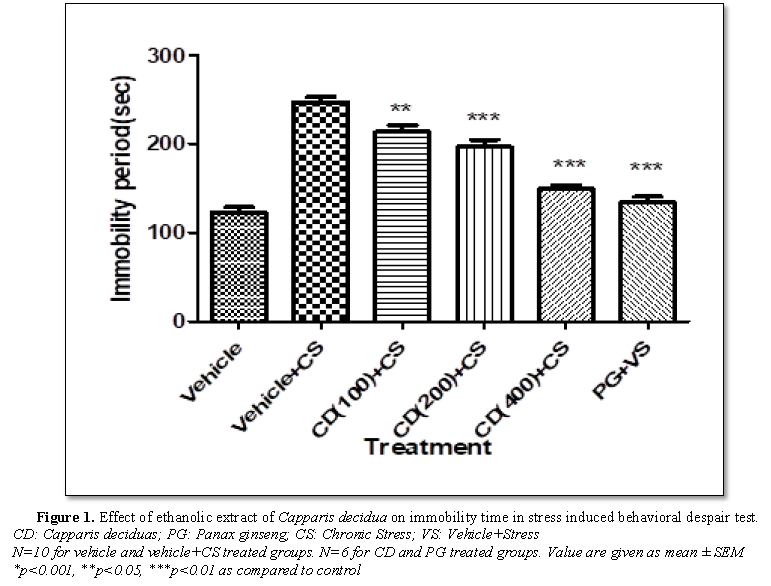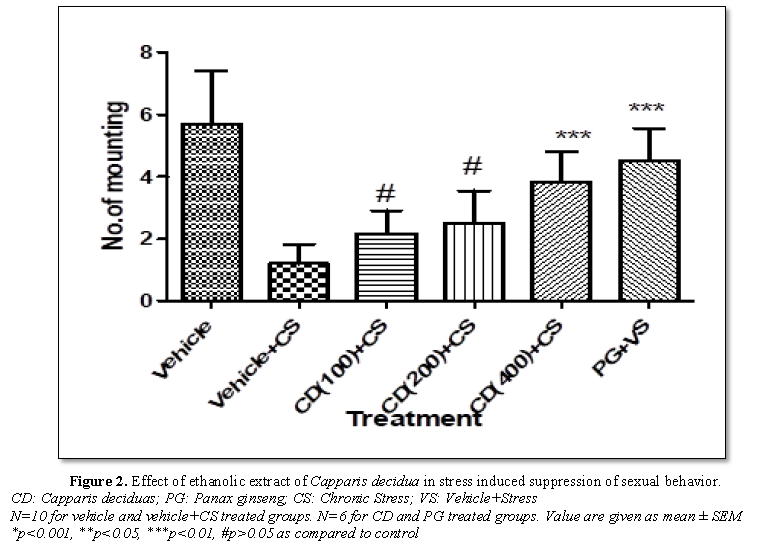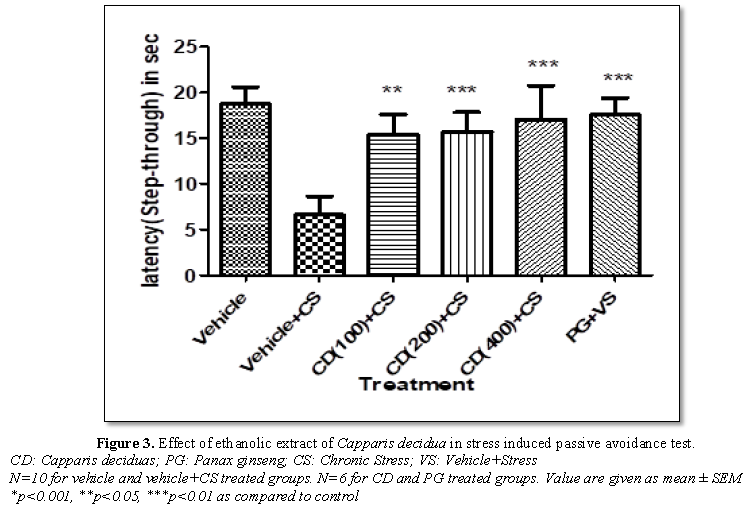729
Views & Citations10
Likes & Shares
The present study was undertaken to
evaluate the anti-stress effect of ethanolic extract of root of Capparis decidua. Capparis decidua was investigated on a 14 day mild, unpredictable
and inescapable foot shock stress induced suppression of sexual behavior,
perturbation in behavior and cognitive dysfunction in experimental rats.
Gastric ulceration and adrenal and spleen weight were also used to assess the
stress intensity. All these chronic stress induced perturbation were attenuated
dose dependently by Capparis deciduas (100, 200 and 400mg/kg, po) and compared
with Panax ginseng (100 mg/kg, po)
which was used as standard adaptogenic agent. The ethanolic extract of root of Capparis decidua at doses of 100, 200 and
400 mg/kg, possess good anti-stress activity.
Keywords: Capparis decidua, Ethanolic extract,
Anti-stress activity
INTRODUCTION
Stress can be described as the sum total of
all reaction of the body, which disturb the normal physiological equilibrium
and result in a state of threatened homeostasis. Stress is a common phenomenon
that is experienced by every individual. When stress becomes extreme, it is
harmful for the body and, hence, need to be treated. Stress is involved in
pathogenesis of variety of diseases that include psychiatric disorders such as
depression and anxiety, immunosuppression, endocrine disorders including
diabetes mellitus, male impotence, cognitive dysfunction, hypertension and
ulcerative colitis [1].
Stress is a condition which is known to alter
the physiological homeostasis of the organism and elicits various endocrinal
and visceral changes such as changes in plasma cortisone and gastric mucosal
integrity. Stress also increases brain serotonin (5-HT) level. The ascending
5-HT neurons from raphe nuclei innervates hypothalamic and limbic sites and
have an overall role in regulating secretions of adrenocorticotrophic hormone
(ACTH) during stress [2].
Capparaceae is a family related to the
Cleomaceae and as well as to the Cruciferae family. It is place in the order
Brassicales and is commonly known as the caper family [3]. The plant is used in
folk medicine as insecticidal and is well known for curing a variety of aliment
such as toothache, cough, asthma, intermittent fever and rheumatism. The seeds
of C. decidua have antibacterial activity
against Vibrio cholerae, Vibrio inaba and Vibrio ettor, while the fruit has anti-atherosclerotic, anti-diabetic,
antihypertensive and anti-hyperlipidemic activity. The shoot and young leaves
have rubifacient and hypocholesterolemic activity. Isocodonocarpin found in the
root of plant was found to be responsible for anti-inflammatory and
anti-asthmatic activity. The alcoholic extract of fruit pulp and root bark
possesses anthelmintic activity.
Since Capparis
decidua has a number of medicinal properties, the present study was
undertaken to evaluate the anti-stress effect on experimental animals. The
anti-stress effect of Capparis decidua
was compared with Panax ginseng (PG).
The PG was selected as a standard adaptogenic agent for comparison.
MATERIAL AND METHODS
Drug treatments
The fresh
specimen sample of root of Capparis
decidua was collected from Botanical garden, Banaras Hindu University;
which where the authentication as well as identification of the Capparis decidua was done by Prof. SD Dubey,
Department of Dravyaguna, Faculty of Ayurveda, Institute of Medical Science,
Banaras Hindu University, Varanasi. A specimen of the plant including the
sample root is deposited
Animals
Foster albino rats (150 ± 10 g)
were used in the study. Animals were obtained from central animal house of
Institute of Medical Sciences, Banaras Hindu University, Varanasi. The animals
were housed in groups of six in polypropylene cages at an ambient temperature
of 25 ± 1°C and 45-55% relative humidity, with a 12:12 h light/dark cycle. Rats
were provided with commercial food pellets and water ad libitum, unless stated otherwise. Rats were
acclimatized to laboratory conditions for at least one week before using them
for experiments. Body weight of rats was measured periodically. Principles of laboratory animal care
guidelines (NIH publication number 85-23, revised 1985) were followed.
Induction of chronic stress
The method of
Armando was used. The stressed rats were subjected daily to 1 h of foot shock
through a grid floor in a shock chamber for 14 consecutive days. The duration
of each shock (2 mA) and the interval between the shocks was randomly
programmed between 3 and 5 s and 10 and 110 s, respectively (in order to make
the shocks unpredictable). Animals were sacrificed on day 14, 1 h after the last
shock procedure and on completion of other test procedure involved [4].
Techniques
used for assessment of stress intensity
The following
parameters were used to assess the intensity of stress-induced effects:
Gastric ulceration:
The change in body weight of rats was observed during the experimental period.
In order to observe ulcerogenic effect of stress and protective effects of CD
and PG, stomach was removed and split open along the greater curvature. The
numbers of discrete ulcers was noted by the help of a magnifying glass. The
severity of the ulcers was scored after histological confirmations, 0=no
ulcers, 1=changes limited to superficial layers of the mucosa with no
congestion, 2=half the mucosal thickness showing necrotic changes and
congestion, 3=more than two-third of mucosal thickness showing necrotic changes
and congestion and 4=complete destruction of the mucosa with marked hemorrhage.
Thereafter, the period ulcer severity score was calculated [5].
Adrenal gland and spleen weights: The adrenal gland and spleen were removed and weighed [6].
Methods used to assess stress-induced perturbations
Stress-induced ‘behavioral depression: The following methods were used to assess behavioral
depression:
(a)
Stress-induced ‘behavioral
despair’ test: Rats
were forced to swim individually in a polypropylene vessel (45 × 40 × 30 cm)
with a water level of 20 cm, which ensured that the rat’s feet does not touch
the floor of the vessel and that it could not climb out of it. The rat was
allowed to swim for 10 min. Thereafter, during the next 5 min, the total period
of immobility, characterized by complete cessation of swimming with the head
floating above water level, was noted. This immobility period, after initial
frenzied attempts to escape, is postulated to represent ‘behavioral despair’ as
an experimental model of endogenous depression [7].
(b)
Learned helplessness test: On day 12 of the investigation,
rats were subjected to foot shock (60 scrambled shocks, 15 s duration, 0.8 mA,
every min) in a two compartment jumping box (Techno) with the escape door to
the adjoining un-electrified compartment closed. The exercise continued for 1
h. On day 14, 48 h later, the rats were subjected to avoidance training, using
the same apparatus but keeping the escape route to the un-electrified chamber
open. During this avoidance training the rats were placed in the electrified
chamber and allowed to acclimatize for 5 min before being subjected to 30
avoidance trials, with an inter-trial interval of 30 s. During the first 3 s of
the trial, a buzzer stimulus (conditioned stimulus, CS) was presented followed
by electroshock (unconditioned stimulus, UCS) (0.8 mA) delivered via the grid
floor for the next 3 s. The avoidance response was characterized by escape to
the adjoining ‘safe’ chamber during CS. Failure to escape during UCS within 15
s was assessed as ‘escape’ failure which is postulated to indicate despair or
depression [8].
Stress-induced suppression of sexual behavior in male
rats: A male rat was placed in a cage in a dimly room for 10
min with 2 estrinised (sequentially treated with estradiol valerate 5 mg/rat, followed 48 h later by
hydroxyprogesterone 1.5 mg/rat, s.c.) female rats. The total numbers of mounts
were counted [9].
Stress-induced cognitive dysfunction: The following parameters were used to assess the effect of
stress on retention of a learned task as memory:
(a)
Active avoidance test: Rats were trained for an active
avoidance task before subjecting them to stress. During training, the rat was
placed in the right electrified compartment of a shuttle box (Techno) and
allowed to acclimatize for 5 min. Thereafter, the animal was subjected to 15 s
of a buzzer stimulus (conditioned stimulus) which was followed by electric
shock (1 mA, 50 Hz) given through the grid floor (unconditioned stimulus). The
rats were given at least 10 trials, with an inter-trial interval of 60 min,
until they reached the criterion of 100% avoidance response of jumping to the
un-electrified left chamber of the shuttle box during conditioned stimulus. The
test was repeated on day 14 in order to assess the retention of the active
avoidance learning [10].
(b)
Passive avoidance test: The test apparatus was a
rectangular box (45 × 30 × 40) with an electrified grid floor. An 8 cm high
platform (17 × 12 cm) was fixed to the centre of the floor. A rat was placed on
the platform and allowed to step down. 24 h later, on day 1 of the experiment,
the rat was again placed on the platform and on stepping down, received foot
shock (0.75 mA, 2 s) through the grid floor. The rat was given 3 more trials
until the latency of step down had stabilized. The test was repeated on day 14
and retention of learning as memory, for each rat was recorded [11-14].
STATISTICAL ANALYSIS
The values are
expressed as mean ± SEM. Statistical significance of the differences between
control and treated groups was calculated using one way analysis of variance
(ANOVA) followed by Dunnet test. P<0.01 was considered to be significant.
RESULTS AND
DISCUSSION
Gastric
ulceration
Chronic stress
markedly increases the number and severity of gastric ulcers. The first doses
of CD (100 mg/kg, po) show less significantly reduction in stress induced
Gastric ulcer than the other dose of CD and PG, but CD (200 mg/kg and 400
mg/kg, po) and PG (100 mg/kg, po) significantly reduced this stress-induced
gastric ulcer (Table 1).
Adrenal cortex and spleen weights
Chronic stress
significantly increases adrenal gland weight and reduction of spleen weight.
These stress induced changes were significantly (P<0.05) reduced by CD (100
mg/kg, 200mg/kg and 400mg/kg, po) and PG (100 mg/kg, po) (Table 2).
Stress induced behavioral despair test
Chronic stress
increased the duration of immobility test, while increasing escape failure with
concomitant decrease in avoidance response in learned helplessness test,
features indicative of depression. CD (200 and 400 mg/kg, po) and PG (100
mg/kg, po) tends to reverse the stress-induced behavioral changes (Figure 1).
Stress-induced inhibition of male sexual behavior
The result
indicates that male, unstressed rats showed more number of mounting when
compared to stress rats. Chronic stress significantly decreases in the number
of mounting. This stress effect was attenuated by CD (100, 200 and 400 mg/kg, po)
and PG (100 mg/kg, po) (Table 3 and
Figure 2).
Active and passive avoidance test
Chronic stress
produced significant decrease in retention of acquired active and passive
learning. These stress induced memory deficits were reduced by CD (200 and 400
mg/kg, po) and PG (100 mg/kg, po) (Table 4 and Figure 3).
CONCLUSION
From above
study it was concluded that all the three doses of Capparis decidua extract showed good anti-stress effect in tested
models. The Capparis decidua extract
significantly reduce the stress induced gastric ulceration, change in adrenal
cortex and spleen weight. Capparis decidua tended to reverse the stress-induced
behavioural changes. Chronic stress significantly decrease the sexual behaviour
of male rats, this stress effect was reversed by Capparis decidua. Stress induced memory deficits were reduced by Capparis decidua extract. The ethanolic
extract of root of Capparis decidua
at doses of 100, 200 and 400 mg/kg, possess good anti-stress activity.
1.
Mazumdar H,
Gogoi D, Buragohain L, Haloi N (2012) A comparative study on stress and its
contributing factors among the graduate and post-graduate students. Adv Appl
Sci Res 3: 399-406.
2.
Carhart-Harris
RL, Nutt DJ (2017) Serotonin and brain function: A tale of two receptors. J
Psychopharmacol 31: 1091-1120.
3.
Jhala AJ, Hall
LM, Hall JC (2008) Potential hybridization of flax with weedy and wild
relatives: An avenue for movement of engineered genes. Crop Sci 48: 825-840.
4.
Tiwari BK,
Valdramidis VP, Donnel CPO, Muthukumarappan K, Bourke P, et al. (2009)
Application of natural antimicrobials for food preservation. J Agric Food Chem
57: 5987-6000.
5.
Bhargava KP,
Singh N (1981) Anti-stress activity of Ocimum sanctum Linn. Indian J Med Res
73: 443-451.
6.
Bhattacharya
SK, Bhattacharya A, Sairam K, Ghosal S (2000) Anxiolytic-antidepressant
activity of Withania somnifera
glycowithanolides: An experimental study. J Phytomed 7: 463-469.
7.
Porsolt RD,
Bertin A, Jalfre M (1977) Behavioral despair in mice: A primary screening test
for antidepressants. Arch Int Pharmacodyn Ther 229: 327-336.
8.
Thiebot MH,
Thiebot P, Martin AJ (1992) Animal behavior studies in the evaluation of
antidepressant drugs. Br J Psychiatr 160: 44-50.
9.
Morishita T
(1993) Characterization of the cyr1-2 UGA mutation in Saccharomyces cerevisiae. Mol Gen Genet 237: 463-466.
10.
Jaiswal N,
Haynesworth SE, Caplan AI, Bruder SP
(1997) Osteogenic differentiation of purified, culture‐expanded human
mesenchymal stem cells in vitro. Cell Biochem 64: 295-312.
11.
Bhattacharya
P, Ghosal SK, Sen K (1991) Effect of physicochemical parameters on the
separation of proteins from human placental extract by using a continuous foam
fractionating column. Journal Separation Science and Technology 1991: 10-11.
12.
Murugan K,
Shrivastava DK, Patil SKB, Sweety L, Debapriya G, et al. (2010) Biochemical investigation
of glycosylated hemoglobin in diabetes associated nephropathy in Chhattisgarh
population. Adv Appl Sci Res 1: 106-113.
13.
Achor RW,
Hanson NO, Gifford RW (1955) Hypertension treated with Rauwolfia serpentina (whole root) and with reserpine; controlled
study disclosing occasional severe depression. J Am Med Assoc 159.
14.
Baumann, MH,
Clark RD, Rothman (2008) Locomotor stimulation produced by 3,4-methylenedioxymethamphetamine
(MDMA) is correlated with dialysate levels of serotonin and dopamine in rat
brain. Pharmacol Biochem Behav 90.
QUICK LINKS
- SUBMIT MANUSCRIPT
- RECOMMEND THE JOURNAL
-
SUBSCRIBE FOR ALERTS
RELATED JOURNALS
- International Journal of Surgery and Invasive Procedures (ISSN:2640-0820)
- Journal of Renal Transplantation Science (ISSN:2640-0847)
- International Journal of Anaesthesia and Research (ISSN:2641-399X)
- Journal of Spine Diseases
- Dermatology Clinics and Research (ISSN:2380-5609)
- Ophthalmology Clinics and Research (ISSN:2638-115X)
- Journal of Cell Signaling & Damage-Associated Molecular Patterns




